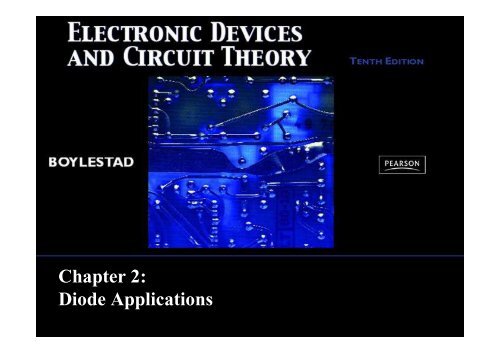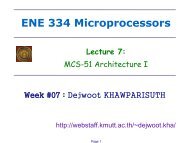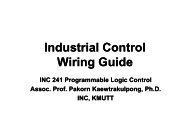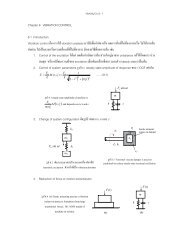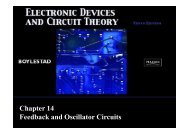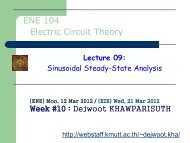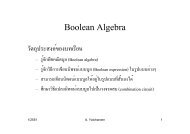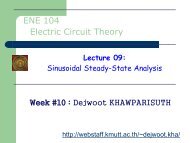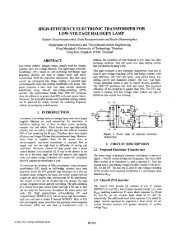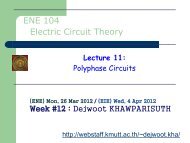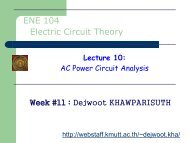Chapter 2: Diode Applications - Webstaff.kmutt.ac.th
Chapter 2: Diode Applications - Webstaff.kmutt.ac.th
Chapter 2: Diode Applications - Webstaff.kmutt.ac.th
- No tags were found...
Create successful ePaper yourself
Turn your PDF publications into a flip-book with our unique Google optimized e-Paper software.
<strong>Chapter</strong> 2:<strong>Diode</strong> <strong>Applications</strong>
Load-Line Line AnalysisThe load line plots all possiblecombinations of diode current (I D )and voltage (V D ) for a given circuit.The maximum I D equals E/R, and<strong>th</strong>e maximum V D equals E.The point where <strong>th</strong>e load line and<strong>th</strong>e char<strong>ac</strong>teristic curve intersect is<strong>th</strong>e Q-point, which identifies I D andV D for a particular diode in a givencircuit.Electronic Devices and Circuit Theory, 10/eRobert L. Boylestad and Louis Nashelsky 2Copyright ©2009 by Pearson Education, Inc.Upper Saddle River, New Jersey 07458 • All rights reserved.
Series <strong>Diode</strong> ConfigurationsConstantsForward Bias• Silicon <strong>Diode</strong>: V D = 0.7 V• Germanium <strong>Diode</strong>: V D = 0.3 VAnalysis (for silicon)• V D = 0.7 V (or V D = E if E < 0.7 V)• V R = E – V D• I D = I R = I T = V R / RElectronic Devices and Circuit Theory, 10/eRobert L. Boylestad and Louis Nashelsky3Copyright ©2009 by Pearson Education, Inc.Upper Saddle River, New Jersey 07458 • All rights reserved.
Series <strong>Diode</strong> ConfigurationsReverse Bias<strong>Diode</strong>s ideally behave as open circuitsAnalysis• V D = E• V R = 0 V• I D = 0 AElectronic Devices and Circuit Theory, 10/eRobert L. Boylestad and Louis Nashelsky4Copyright ©2009 by Pearson Education, Inc.Upper Saddle River, New Jersey 07458 • All rights reserved.
Parallel ConfigurationsVDVD1VRIRID1===0.7 VVD29.3 VID2=E−V=DR==VO2=28 mA0.7 V10 V−.7 V=.33kΩ== 14 mA28 mAElectronic Devices and Circuit Theory, 10/eRobert L. Boylestad and Louis Nashelsky 5Copyright ©2009 by Pearson Education, Inc.Upper Saddle River, New Jersey 07458 • All rights reserved.
Half-Wave RectificationThe diode onlyconducts when it isforward biased,<strong>th</strong>erefore only halfof <strong>th</strong>e AC cyclepasses <strong>th</strong>rough <strong>th</strong>ediode to <strong>th</strong>eoutput.The DC output voltage is 0.318V m , where V m = <strong>th</strong>e peak AC voltage.Electronic Devices and Circuit Theory, 10/eRobert L. Boylestad and Louis Nashelsky 6Copyright ©2009 by Pearson Education, Inc.Upper Saddle River, New Jersey 07458 • All rights reserved.
PIV (PRV)Because <strong>th</strong>e diode is only forward biased for one-half of <strong>th</strong>e AC cycle, it isalso reverse biased for one-half cycle.It is important <strong>th</strong>at <strong>th</strong>e reverse breakdown voltage rating of <strong>th</strong>e diode behigh enough to wi<strong>th</strong>stand <strong>th</strong>e peak, reverse-biasing AC voltage.PIV (or PRV) > V m• PIV = Peak inverse voltage• PRV = Peak reverse voltage• V m = Peak AC voltageElectronic Devices and Circuit Theory, 10/eRobert L. Boylestad and Louis Nashelsky 7Copyright ©2009 by Pearson Education, Inc.Upper Saddle River, New Jersey 07458 • All rights reserved.
Full-Wave RectificationThe rectification process can be improved byusing a full-wave rectifier circuit.Full-wave rectification produces a greaterDC output:• Half-wave: V dc = 0.318V m• Full-wave: V dc = 0.636V mElectronic Devices and Circuit Theory, 10/eRobert L. Boylestad and Louis Nashelsky 8Copyright ©2009 by Pearson Education, Inc.Upper Saddle River, New Jersey 07458 • All rights reserved.
Full-Wave RectificationBridge Rectifier• Four diodes are connected in abridge configuration• V DC = 0.636V mElectronic Devices and Circuit Theory, 10/eRobert L. Boylestad and Louis Nashelsky 9Copyright ©2009 by Pearson Education, Inc.Upper Saddle River, New Jersey 07458 • All rights reserved.
Full-Wave RectificationCenter-Tapped TransformerRectifierRequires• Two diodes• Center-tapped transformerV DC = 0.636V mElectronic Devices and Circuit Theory, 10/eRobert L. Boylestad and Louis Nashelsky 10Copyright ©2009 by Pearson Education, Inc.Upper Saddle River, New Jersey 07458 • All rights reserved.
Summary of Rectifier CircuitsRectifierHalf Wave RectifierIdeal V DCV DC = 0.318V mRealistic V DCV DC = 0.318V m – 0.7Bridge RectifierV DC = 0.636V mV DC = 0.636V m – 2(0.7 V)Center-Tapped TransformerRectifierV DC = 0.636V mV DC = 0.636V m – 0.7 VV m = peak of <strong>th</strong>e AC voltage.In <strong>th</strong>e center tapped transformer rectifier circuit, <strong>th</strong>e peak AC voltageis <strong>th</strong>e transformer secondary voltage to <strong>th</strong>e tap.Electronic Devices and Circuit Theory, 10/eRobert L. Boylestad and Louis Nashelsky 11Copyright ©2009 by Pearson Education, Inc.Upper Saddle River, New Jersey 07458 • All rights reserved.
<strong>Diode</strong> ClippersThe diode in a series clipper “clips”any voltage <strong>th</strong>at does not forwardbias it:• •A reverse-biasing polarity•A forward-biasing polarity less <strong>th</strong>an0.7 V (for a silicon diode)Electronic Devices and Circuit Theory, 10/eRobert L. Boylestad and Louis Nashelsky 12Copyright ©2009 by Pearson Education, Inc.Upper Saddle River, New Jersey 07458 • All rights reserved.
Biased ClippersAdding a DC source inseries wi<strong>th</strong> <strong>th</strong>e clippingdiode changes <strong>th</strong>eeffective forward bias of<strong>th</strong>e diode.Electronic Devices and Circuit Theory, 10/eRobert L. Boylestad and Louis Nashelsky 13Copyright ©2009 by Pearson Education, Inc.Upper Saddle River, New Jersey 07458 • All rights reserved.
Parallel ClippersThe diode in a parallel clippercircuit “clips” any voltage <strong>th</strong>atforward bias it.DC biasing can be added inseries wi<strong>th</strong> <strong>th</strong>e diode to change<strong>th</strong>e clipping level.Electronic Devices and Circuit Theory, 10/eRobert L. Boylestad and Louis Nashelsky 14Copyright ©2009 by Pearson Education, Inc.Upper Saddle River, New Jersey 07458 • All rights reserved.
Summary of Clipper Circuitsmore…Electronic Devices and Circuit Theory, 10/eRobert L. Boylestad and Louis Nashelsky 15Copyright ©2009 by Pearson Education, Inc.Upper Saddle River, New Jersey 07458 • All rights reserved.
Summary of Clipper CircuitsElectronic Devices and Circuit Theory, 10/eRobert L. Boylestad and Louis Nashelsky 16Copyright ©2009 by Pearson Education, Inc.Upper Saddle River, New Jersey 07458 • All rights reserved.
ClampersA diode and cap<strong>ac</strong>itor can becombined to “clamp” an ACsignal to a specific DC level.Electronic Devices and Circuit Theory, 10/eRobert L. Boylestad and Louis Nashelsky 17Copyright ©2009 by Pearson Education, Inc.Upper Saddle River, New Jersey 07458 • All rights reserved.
Biased Clamper CircuitsThe input signal can be any typeof waveform such as sine, square,and triangle waves.The DC source lets you adjust<strong>th</strong>e DC camping level.Electronic Devices and Circuit Theory, 10/eRobert L. Boylestad and Louis Nashelsky 18Copyright ©2009 by Pearson Education, Inc.Upper Saddle River, New Jersey 07458 • All rights reserved.
Summary of Clamper CircuitsElectronic Devices and Circuit Theory, 10/eRobert L. Boylestad and Louis Nashelsky 19Copyright ©2009 by Pearson Education, Inc.Upper Saddle River, New Jersey 07458 • All rights reserved.
Zener <strong>Diode</strong>sThe Zener is a diode operatedin reverse bias at <strong>th</strong>e ZenerVoltage (V z ).• When V i ≥ V Z– The Zener is on– Voltage <strong>ac</strong>ross <strong>th</strong>e Zener is V Z– Zener current: I Z = I R – I RL– The Zener Power: P Z = V Z I Z• When V i < V Z– The Zener is off– The Zener <strong>ac</strong>ts as an open circuitElectronic Devices and Circuit Theory, 10/eRobert L. Boylestad and Louis Nashelsky 20Copyright ©2009 by Pearson Education, Inc.Upper Saddle River, New Jersey 07458 • All rights reserved.
Voltage-Multiplier CircuitsVoltage multiplier circuits use a combination of diodes andcap<strong>ac</strong>itors to step up <strong>th</strong>e output voltage of rectifier circuits.• Voltage Doubler• Voltage Tripler• Voltage QuadruplerElectronic Devices and Circuit Theory, 10/eRobert L. Boylestad and Louis Nashelsky 22Copyright ©2009 by Pearson Education, Inc.Upper Saddle River, New Jersey 07458 • All rights reserved.
Voltage DoublerThis half-wave voltage doubler’s output can be calculated by:V out = V C2 = 2V mwhere V m = peak secondary voltage of <strong>th</strong>e transformerElectronic Devices and Circuit Theory, 10/eRobert L. Boylestad and Louis Nashelsky 23Copyright ©2009 by Pearson Education, Inc.Upper Saddle River, New Jersey 07458 • All rights reserved.
Voltage Doubler• Positive Half-Cycleo D 1 conductso D 2 is switched offo Cap<strong>ac</strong>itor C 1 charges to V m• Negative Half-Cycleo D 1 is switched offo D 2 conductsoCap<strong>ac</strong>itor C 2 charges to V mV out = V C2 = 2V mElectronic Devices and Circuit Theory, 10/eRobert L. Boylestad and Louis Nashelsky 24Copyright ©2009 by Pearson Education, Inc.Upper Saddle River, New Jersey 07458 • All rights reserved.
Voltage Tripler and QuadruplerElectronic Devices and Circuit Theory, 10/eRobert L. Boylestad and Louis Nashelsky 25Copyright ©2009 by Pearson Education, Inc.Upper Saddle River, New Jersey 07458 • All rights reserved.
Pr<strong>ac</strong>tical <strong>Applications</strong>• Rectifier Circuits– Conversions of AC to DC for DC operated circuits– Battery Charging Circuits• Simple <strong>Diode</strong> Circuits– Protective Circuits against– Overcurrent– Polarity Reversal– Currents caused by an inductive kick in a relay circuit• Zener Circuits– Overvoltage Protection– Setting Reference VoltagesElectronic Devices and Circuit Theory, 10/eRobert L. Boylestad and Louis Nashelsky26Copyright ©2009 by Pearson Education, Inc.Upper Saddle River, New Jersey 07458 • All rights reserved.


